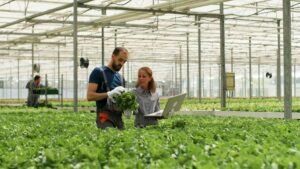As sustainability and technological innovation become paramount across various sectors, the Europe Smart Farming Market is set for significant expansion.
With modern agriculture grappling with the challenges of environmental stewardship and rising food requirements, the continent is swiftly embracing intelligent farming solutions driven by cutting-edge technologies such as IoT, artificial intelligence, robotics, and data analytics.
This movement is supported by farmers, policymakers, and investors, fostering a dynamic environment conducive to the growth of smart farming.
In this landscape, it is crucial for stakeholders to understand the primary drivers, opportunities, and challenges to effectively leverage this evolving market.
Increasing Food Demand and Resource Efficiency
As the population in Europe continues to grow, the agricultural sector faces mounting pressure to fulfill food needs while conserving finite resources.
As a result, numerous farms are adopting data-driven approaches that enhance precision, control, and sustainability.
Smart farming technologies enable real-time monitoring and predictive analytics, which enhance decision-making processes.
For example, farmers can utilize sensors to identify the best times for irrigation, resulting in substantial water conservation.
Similarly, data analytics can inform choices regarding fertilization and harvesting, ensuring that resources are utilized efficiently and responsibly.
Supportive Government Policies and Strategic Initiatives
Crucially, government initiatives have been instrumental in promoting the adoption of smart agriculture.
European governments are actively encouraging digital farming through legislation, subsidies, and research programs that advocate for sustainable agricultural practices.
These initiatives not only alleviate the financial pressures on farmers but also establish a cohesive framework for the advancement of smart agriculture.
Additionally, numerous countries within the EU are integrating smart farming objectives into their environmental sustainability initiatives.
This legislative support guarantees that agricultural innovation is in harmony with wider climate and ecological goals.
Growth of the Agritech Start-Up Ecosystem: Europe Smart Farming Market
In conjunction with governmental initiatives, Europe’s dynamic agritech start-up ecosystem is driving market growth.
Start-ups specializing in drone technology, crop monitoring, automated irrigation, and livestock tracking are increasingly attracting interest from both investors and agricultural producers.
As capital flows into these promising enterprises, the smart farming sector becomes more diverse and accessible.
With intuitive platforms and scalable solutions, even smaller farms can implement precision agriculture without incurring significant initial expenses.
This technological democratization is essential for fostering sustainable practices in the long run.
Crop Monitoring and Yield Prediction
One of the prevalent applications is crop monitoring, utilizing drones, GPS technology, and sensors to deliver comprehensive insights into crop health, soil moisture levels, and pest presence.
These insights not only aid in mitigating crop loss but also enhance yield predictions, facilitating more effective inventory and logistics management.

Livestock and Greenhouse Oversight
In addition to crop management, smart farming technologies are transforming livestock oversight and greenhouse management.
Farmers can track animal health, feeding habits, and movements through wearable technology, thereby enhancing productivity and animal welfare.
Simultaneously, automated greenhouse systems regulate temperature, lighting, and humidity, ensuring optimal growth conditions with minimal human involvement.
Farm Management Software and IoT Integration
Digital platforms form the foundation of the smart farming landscape in Europe, consolidating data from various sources into a unified system.
This software enables farmers to gain comprehensive visibility over their operations from field data to financial metrics empowering them to make informed, strategic decisions.
Rapid Market Growth Forecasted Through 2034
Industry analysis indicates that the smart farming market in Europe is expected to expand from $3.98 billion in 2024 to $22.19 billion by 2034.
This signifies an impressive compound annual growth rate (CAGR) of 18.73%. This projection is consistent with global trends that prioritize sustainability and efficiency in food production.
Focus on Food Security and Environmental Sustainability
In the coming years, the dual objectives of ensuring food security and protecting the environment will continue to spur innovation.
As climate change presents new challenges for agricultural producers, the demand for adaptive, technology-based farming solutions will become increasingly urgent.
Fortunately, smart farming technologies are ideally positioned to deliver the responsive and scalable solutions that future agriculture will require.
Strategic Approaches and Market Potential
To thrive in this expanding market, organizations must implement a holistic strategy.
This involves pinpointing underserved market segments, investing in cutting edge solutions, and ensuring product alignment with environmental standards.
Additionally, effective marketing and customer education are essential for building trust and enhancing adoption rates.
As competition intensifies, companies that provide scalable, user friendly, and cost-efficient smart farming solutions are likely to rise as leaders in the market.
Those that incorporate sustainability into their fundamental value propositions will not only satisfy regulatory requirements but also attract environmentally conscious consumers and investors.
Expert Editorial Comment
In summary, the Europe Smart Farming Market is positioned for significant growth, fueled by technological advancements, environmental imperatives, and strategic investments.
As conventional farming practices come under increased scrutiny, the transition to intelligent and sustainable agriculture is not merely a trend it is an essential evolution.
Entities that embrace this movement are likely to achieve a competitive advantage in an ever changing environment.
By leveraging appropriate tools, forming strategic partnerships, and implementing effective strategies, participants throughout the agricultural value chain can significantly influence the future of farming in Europe.

